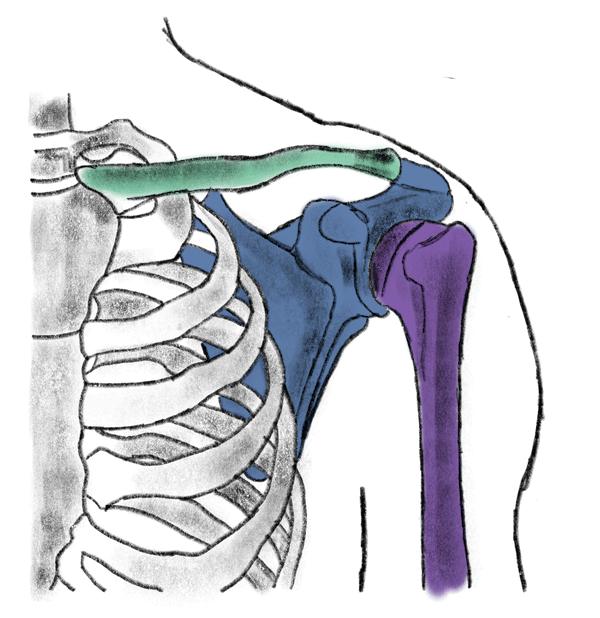Common Shoulder Complaints
We’ve seen a large number of shoulder complaints come through the clinic recently, so we have put together some basic info about shoulder anatomy, common conditions, symptoms to look out for and exercises to help strengthen your shoulders, recover from and prevent shoulder pain and injuries.
Scroll down to read more and watch the videos with our Physiotherapist Jesse Dean!
LEARN ABOUT Shoulder Anatomy
The shoulder is a complex joint involving the humerus (upper arm bone) shown in purple, scapula (shoulder blade) in blue & the clavicle (collarbone) in green.
The cup (glenoid) of the humerus is relatively shallow and rimmed with a cartilage known as the labrum. The labrum acts to improve the stability of your shoulder, while the glenoid allows for a large range of movement.
Watch the video below for more:
Top 3 Shoulder Complaints
1. Subacromial Bursitis
Common Symptoms:
Pain reaching overhead, behind the back or taking your arm out to the side
Tenderness on the top of the shoulder
Aching pain down the side of the upper arm
2. Labral Tears
Common Symptoms:
A deep aching pain in the shoulder joint
Feelings of instability or not trusting your shoulder
Difficulty with weight bearing on the affected shoulder
3. Acromioclavicular (AC) Joint Injuries
Common Symptoms:
Pain reaching across your body or when the arm is reaching overhead
Tenderness on the tip of the shoulder blade and end of the collar bone
How Can You Strengthen Your Shoulders?
Jesse has collated his top 5 exercises to help his patients regain their shoulder function. Though we believe that exercise is an essential component in maintain musculoskeletal health, there are no ‘one size fits all’ exercise strategies. Please consult with your physiotherapist if you’re currently experiencing shoulder pain or have concerns about your shoulder function.
1. Wall Angels
Thoracic extension & scapula control are important components in using your arms overhead. Often people can have restrictions in these areas, as we often see patients using compensatory strategies which don’t work in the long term.
Try this deceptive exercise and discover how it can help with your overhead movements.
2. Behind The Back Towel Pull
Restricted shoulder mobility can greatly impair the function of your shoulders. Stiffness can decrease your ability to reach behind you, put on a jacket or reach for the top shelf.
This simple mobility drill will help you maintain and improve your shoulder mobility allowing you to function at your best.
3. Clock Face Wall Touches
Strengthening your back or shoulders involves more than a cable row & shoulder press. This exercise will challenge your ability to maintain scapula organisation while strengthening your posterior shoulder in a varied range of directions.
If you’re looking to feel the burn, increase shoulder stability and improve your overhead strength, don’t be afraid to add this exercise to your shoulder routine.
4. Single Arm Ball Circles
Scapulothoracic & Glenohumeral control are essential in keeping your shoulders happy. The Serratus Anterior plays a pivotal role in both functions, though many people don’t know what it is.
This exercise is fantastic for developing your Serratus control and improving your shoulder function with pushing movements, while increasing your shoulder muscle endurance at the same time!
5. Resisted Y - T - W’s
Strengthen your scapulothoracic stabilisers (Rhomboids & Trapezius) and glenohumeral stabilisers (Rotator Cuff).
This dynamic exercise can help keep you strong for overhead movements and help you maintain shoulder control under load.

